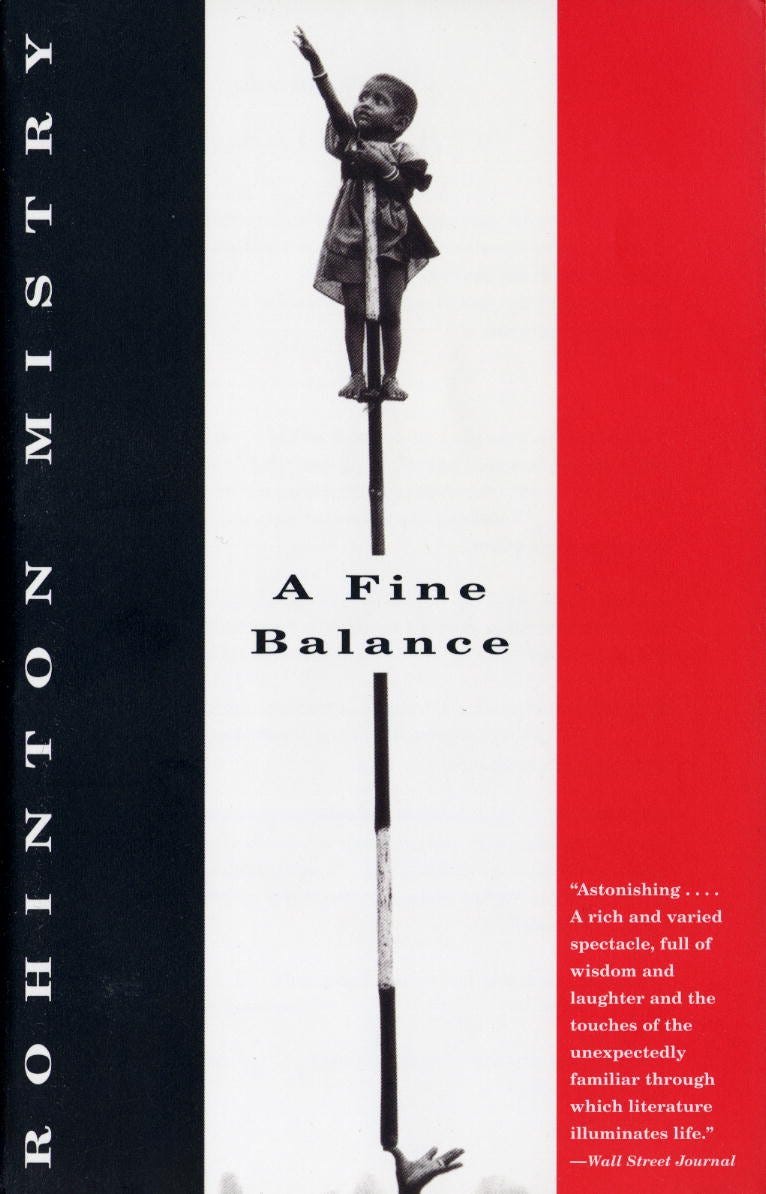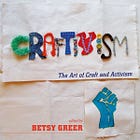Literature as a Lens for Understanding the Limitations and Potential of Craftivism
5 global books that celebrate the power of craft while acknowledging that it can't solve everything
"My interest in smallness is driven by a desire to make reasonable claims on behalf of craft’s power in an era when modest impact feels like an unwelcome truth in academic research." – Jessica Hemmings
I've been reading an article (titled: Rereading and revising: acknowledging the smallness (sometimes) of craft) by Jessica Hemmings for my thesis work. My own paper argues for the power of craftivism to create significant personal and social change, but I'm intrigued by what Hemmings adds to this in her paper which is about the nuanced role of craft in society, emphasizing the limitations of craftivism’s power but saying that the limitations are part of the small power of it all. Hemmings takes a fascinating approach by using literature to explore both the limitations and potentials of craft.
Literature as a Lens for Understanding Craft
In her work, Hemmings dives into novels and short stories from diverse cultural backgrounds—Zimbabwe, Chile, and India—to provide a rich context for understanding craft. These literary examples serve as a lens through which we can see how craft is intertwined with cultural practices, personal identities, and socio-political realities. It's a reminder that craft isn't just about making things; it's about the stories and meanings we weave into those things.
3 Key Lessons from Zimbabwean Stories
Jessica Hemmings' exploration of craft through Zimbabwean literature provides valuable insights into the cultural, social, and political dimensions of craft. By examining the works of Yvonne Vera, Tsitsi Dangarembga, and Brian Chikwava, Hemmings highlights how craft practices are deeply intertwined with the lived experiences of Zimbabwean women and communities. Here are three key lessons from these stories:
Craft as a Means of Resilience
Yvonne Vera’s collection of short stories, "Why Don’t You Carve Other Animals," offers a poignant look at the role of craft in the lives of Zimbabwean women. Hemmings draws attention to how Vera portrays craft as a form of resilience and resistance against socio-political and personal adversities.
Craft serves as a vital means of personal and communal resilience. Through the act of carving, knitting, or weaving, characters in Vera's stories reclaim a sense of agency and identity amidst challenging circumstances. Hemmings teaches us that craft is not merely a domestic activity but a powerful tool for enduring and overcoming oppression.
However, Hemmings also emphasizes that while craft can offer personal empowerment and localized resistance, it may not always translate into broader socio-political change. The smallness of craft here lies in its intimate, individual impact rather than large-scale societal transformation. This smallness, while a limitation, also highlights the unique personal and immediate power of craft.
Craft and Identity
In "The Book of Not," Tsitsi Dangarembga explores the intersection of colonialism, gender, and identity. Hemmings highlights how craft activities, such as knitting and sewing, play a crucial role in the characters' lives, serving as a means of asserting their identities and resisting colonial and patriarchal pressures.
Craft is a form of identity expression and resistance. Dangarembga's portrayal of craft activities underscores their importance in helping women navigate and challenge oppressive structures. Hemmings illustrates that through crafting, women in Zimbabwe assert their individuality and resilience, contributing to a broader narrative of resistance and empowerment.
Hemmings points out that this form of empowerment is often small-scale and personal. Craft allows for the preservation of identity and culture within oppressive systems but does not always dismantle these systems. The limitation is clear: craft can maintain cultural identity and provide personal solace but may struggle to enact systemic change. This small-scale impact, while limited, is vital in maintaining cultural heritage and personal identity.
Craft as Cultural Reflection
Brian Chikwava’s "Harare North" provides a contemporary perspective on the role of craft within the socio-political landscape of Zimbabwe. Hemmings examines how Chikwava’s depiction of craft practices reflects the cultural and economic realities faced by Zimbabweans in a globalized world.
Craft reflects and responds to cultural and economic challenges. Chikwava’s narrative shows that craft is not only a means of survival but also a way to critique and engage with broader societal issues. Hemmings teaches us that craft practices in Zimbabwe serve as a mirror to the cultural and economic struggles, highlighting their relevance in contemporary discourse.
That said, she also notes that the smallness of craft is evident in its often symbolic rather than pragmatic impact. While craft can highlight and reflect issues, it may lack the power to directly change economic or political conditions, emphasizing its limitations in effecting large-scale change. Yet, this smallness allows for personal and cultural expression that larger movements might overlook.
A Lesson from Chile
Isabel Allende’s novel "The House of the Spirits" is a seminal work that intertwines magical realism with the socio-political history of Chile. Hemmings highlights how Allende uses the character of Clara, who engages in embroidery and other crafts, to demonstrate the deeply rooted cultural significance of these practices in the lives of Chilean women.
Craft in "The House of the Spirits" serves as a medium for personal expression and resilience. Clara’s embroidery, for example, is not just a pastime but a way for her to navigate the political and personal upheavals she faces. Through Clara’s intricate and meaningful work, Allende illustrates how craft can be a source of strength and continuity in the midst of chaos. Hemmings uses this literary example to show that craft holds profound personal and cultural significance, serving as a form of resistance and a means to assert identity and agency.
Hemmings also acknowledges that the impact of such craft practices is often confined to the personal and familial sphere, highlighting the smallness of craft in the face of broader political turmoil. This personal empowerment is significant but modest compared to the larger socio-political struggles it intersects with, yet it is precisely this smallness that makes it accessible and meaningful in everyday life.
A Lesson from India
In Rohinton Mistry’s "A Fine Balance," the lives of the characters are intricately connected to their craft practices, which provide solace and a sense of purpose amidst the socio-political turmoil of India. Hemmings points to how Mistry depicts the small, everyday acts of craft as essential to the characters’ survival and dignity.
Craft in "A Fine Balance" symbolizes resistance and survival. The characters’ engagement in sewing and other crafts is portrayed as a lifeline, offering them moments of peace and self-worth in an otherwise oppressive environment. Hemmings highlights that through these literary depictions, we see how craft can empower individuals, giving them the strength to endure and resist systemic injustices. Mistry’s narrative underscores the significant role of craft in providing a sense of normalcy and control in the face of adversity.
Hemmings also cautions that the impact of these crafts remains small and personal, rarely extending beyond the immediate lives of the characters. The limitation here is that while craft can offer personal empowerment and resistance, it often lacks the capacity to instigate broader societal change. This small, personal impact is crucial for individual well-being and serves as a form of quiet resistance and endurance in oppressive systems.
You Might Also Like to Read:
If you read this far, perhaps you liked the work. The work does take work. It only continues with support, so please consider subscribing. My annual rate starts at $10 per year.










